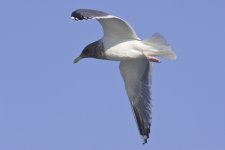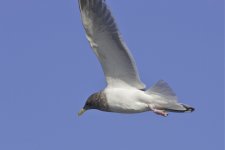Terry Townshend
Regular vagrant
Hello..
I saw this rather striking gull at Choshi, Japan last week. The most common large white-headed gull in the area is Vega Gull (Larus vegae) but I guess other species (eg American Herring) are possible.
Does anyone know if this is within the variation of Vega? I can't seem to find any similar images anywhere. The primary pattern looks ok for this species but the bill is quite pale with hardly any red on the gonys.
My assumption is that it is a heavily streaked Vega but I thought I'd post the images to see what others thought.. In any case a very smart individual!
Thanks..
Terry
I saw this rather striking gull at Choshi, Japan last week. The most common large white-headed gull in the area is Vega Gull (Larus vegae) but I guess other species (eg American Herring) are possible.
Does anyone know if this is within the variation of Vega? I can't seem to find any similar images anywhere. The primary pattern looks ok for this species but the bill is quite pale with hardly any red on the gonys.
My assumption is that it is a heavily streaked Vega but I thought I'd post the images to see what others thought.. In any case a very smart individual!
Thanks..
Terry





